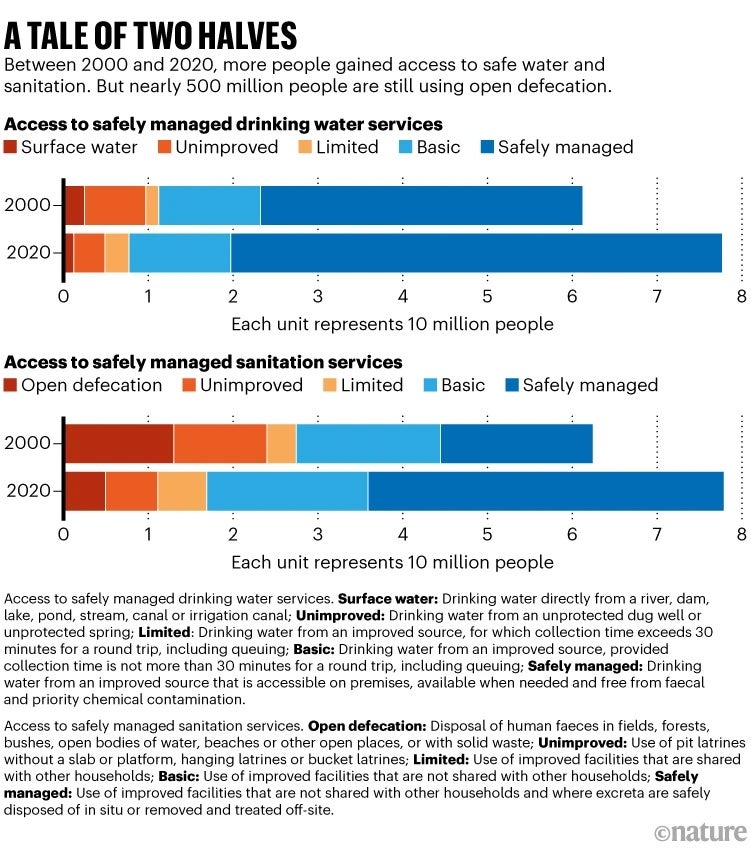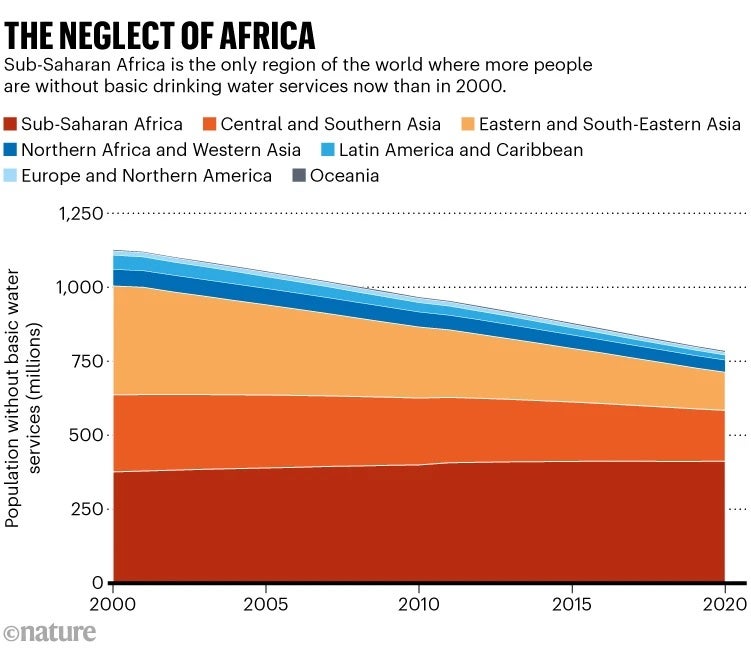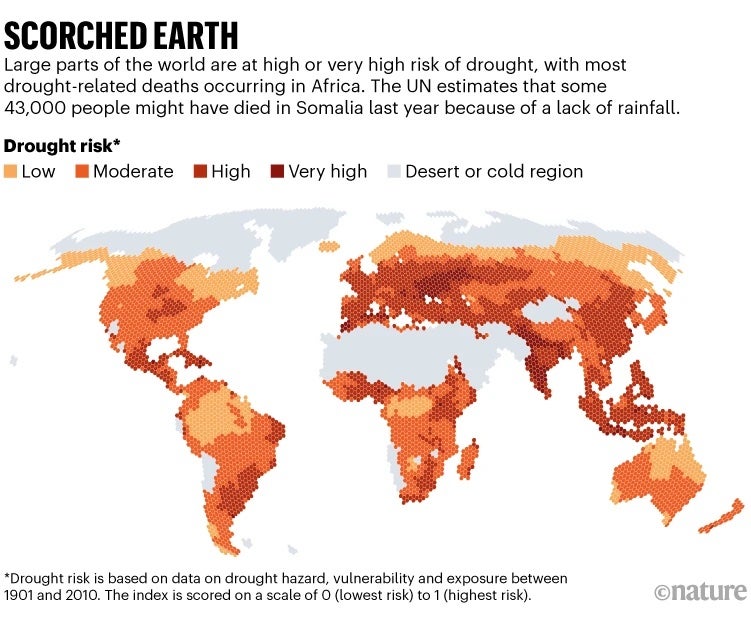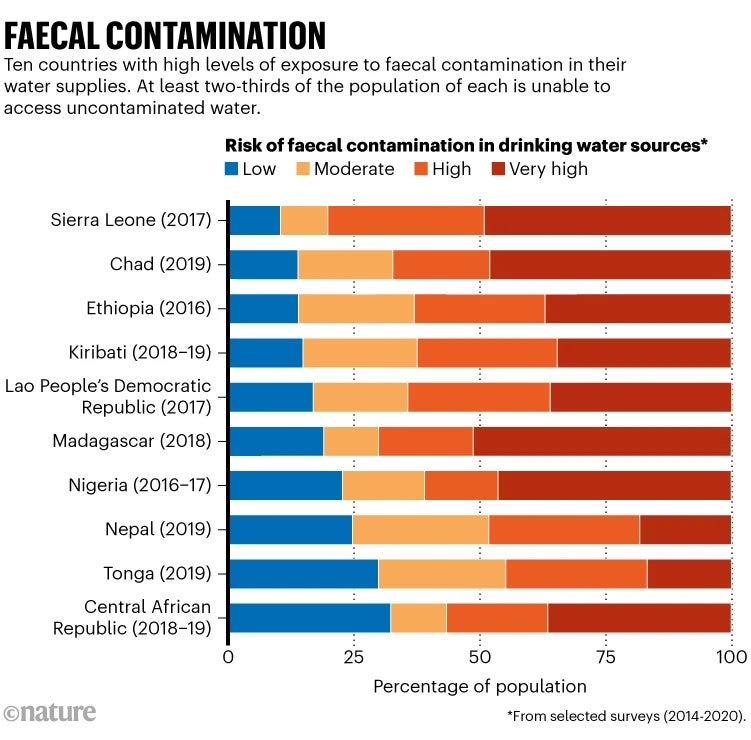The United Nations water conference started this week. Co-hosted by the Netherlands and Tajikistan, the three-day event will take place at UN headquarters in New York and will be the first such event in nearly half a century. During that time, a rising number of people around the world have gained access to safe water and sanitation (see ‘A tale of two halves’) — except in sub-Saharan Africa (see ‘The neglect of Africa’), where the numbers without safe drinking-water services are greater than they were in 2000. Globally, around 500 million people are compelled to use open defecation, and millions more rely on contaminated water supplies. Can this conference make a difference?

Why has it taken the United Nations 46 years to organize a conference dedicated to water?
The simplest answer is that water (as a standalone topic) has not been high on the international sustainable-development policy agenda — at least, not until now, says Rachael McDonnell, deputy director-general for research for development at the International Water Management Institute, based in Rome.
The first UN water conference took place in Mar del Plata, Argentina, in 1977. Representatives of 118 countries and territories met over 12 days and issued the Mar del Plata Action Plan, which recommended that countries achieve universal clean water and sanitation by 1990 to avoid a global water crisis by the end of the twentieth century.
Several low-income countries asked for financial support, but were rebuffed, and instead a study was proposed on how to finance water projects, as Nature reported at the time.
In 2015, the international community set a 2030 target (under the UN Sustainable Development Goals, SDGs) for providing clean water and sanitation to all. As of 2020, some 2 billion people still lacked safe drinking water in their homes, and around one-third of people did not have basic handwashing facilities at home, according to data from the World Health Organization (WHO) and the UN children’s agency UNICEF. At current rates of improvement, 1.6 billion people will still lack safe drinking water at home by the 2030 deadline.

Water was not a priority for the September 2021 UN conference on food security, nor last year’s climate COP27 in Egypt, says Henk Ovink, the Netherlands’ special envoy for international water affairs. Water must have a firm place in any follow-up UN process, he stresses. These include the UN Food Systems Stocktaking Moment that will take place in Rome in July, the SDG Summit in September in New York, and COP28 in Dubai in November. “We can’t wait another 46 years because what is happening is just too awful at the moment, and it’s going to get worse,” says McDonnell.
Where is the crisis at its worst?
The water crisis is worst in low-income countries — for example, an estimated 70% of the population of sub-Saharan Africa lacks safe drinking-water services.
The conference needs to prioritize addressing water insecurity in vulnerable communities and those in conflict and post-conflict settings, says Carol Cherfane, director of the Arab Centre for Climate Change Policies, a think-tank connected to the UN based in Beirut. A report published this week by UNICEF and the WHO says that as many as 43,000 people might have died last year from drought in Somalia (see ‘Scorched Earth’).

Providing better access to water for health care and sanitation is another urgent priority. Too many people have no choice but to use contaminated water supplies (see ‘Faecal contamination’). In 2021, one in 10 health-care facilities worldwide had no sanitation services and some 857 million people had no water service at their health-care facility, according to an earlier joint report also by the WHO and UNICEF summarizing 20 years of data on water and sanitation.
The conference will also discuss a plan for countries that share their water resources to communicate more effectively. The Transboundary Water Cooperation Coalition was launched at the Paris headquarters of the UN science agency UNESCO at the end of last year. This will be particularly important for countries in the Middle East and North Africa. Around two-thirds “of the water resources in Arab states flow from outside of their national borders”, says Cherfane. “A transboundary basin-level approach is very important, not as an instrument of creating conflicts, but as an instrument of creating opportunity for conversations and cooperation and coordination.”
How is climate change affecting water resources?
Around half of the world’s population is already at risk of severe water scarcity for at least some of the year, according to the latest (sixth) assessment report from the Intergovernmental Panel on Climate Change, published this week. This number is likely to increase owing to the effects of climate change, such as heavy precipitation, flooding, drought and wildfire events. If global temperatures reach 1.5°C above pre-industrial temperatures, extreme agricultural (soil moisture) drought is expected to be twice as likely in many parts of the world.
Will the conference lead to a legally binding water treaty?
The conference will produce a ‘water action agenda’. But this will involve “voluntary commitments”, says McDonnell. “There’s nothing binding, there is no equivalent to the Paris [climate] agreement.” Moreover, there’s no leading UN body that is responsible for implementing and monitoring progress for all water-related SDGs. “The conference finds itself in an institutional void,” says Ovink. “While we are now very busy with the water conference, we’re not very busy with water.”
But setting up a new treaty or institutional UN body will take many years. Instead, delegates will call for water to be prioritized in existing treaties and in the UN system.
Some countries will be calling for more funds, especially in the form of grants for projects such as desalination of seawater or wastewater treatment. Much existing international support is loans, says Omar Salameh, a spokesman for Jordan’s water and irrigation ministry, based in Amman. “However, loans exacerbate the financial pressures on already-struggling economies,’ he says.

UN secretary-general António Guterres is also expected to ramp up fundraising for his plan, announced at COP27, to create climate early-warning systems in all UN member states, so that countries are better prepared for extreme events. “Only half of our 193 members have proper early-warning services in place,” says Petteri Taalas, secretary-general of the World Meteorological Organization, based in Geneva, Switzerland, which is working with Guterres to implement the plan. “We need some US$3 billion during the coming five years,” adds Taalas. So far, around 10% of this has been raised, through different sources.
This article is reproduced with permission and was first published on March 21, 2022.
Stay connected with us on social media platform for instant update click here to join our Twitter, & Facebook
We are now on Telegram. Click here to join our channel (@TechiUpdate) and stay updated with the latest Technology headlines.
For all the latest For News Update Click Here
